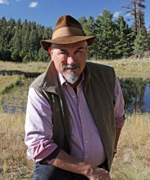 —Alan Dulaney
—Alan Dulaney
And it begins.
On July 26, ADWR and CAWCD co-hosted a meeting on the Lower Basin Drought Contingency Plan or LBDCP (new acronym, same concept). Tom Buschatzke (ADWR Director) and Ted Cooke (CAWCD General Manager) are co-chairs of a 40 member steering committee charged with coming up with a way to implement LBDCP in Arizona. The opening meeting was relatively benign and calm, with Ted and Tom outlining the process and the ultimate goal: achieving consensus on a plan for Arizona that the Legislature could approve in the upcoming session, allowing Tom to sign on to the LBDCP agreement for Arizona. That’s a lot for a very short time period; this needs to be wrapped up by December 2018. You can see their slides here.
Forty members make an unwieldy steering committee. Each represents its own organization, and the hope of the co-chairs is that they represent their respective sectors as well. Accordingly, the various sectors laid out their opening positions. The tribes want the existing priorities for CAP deliveries to stay in place. Agriculture — meaning mostly Pinal County — wants water to mitigate the immediate impacts of the LBDCP, which right now looks like a huge cut to irrigation. The cities want the LBDCP to be approved but are wary of being asked to give up major volumes of water and money. Developers want CAGRD to survive the disappearance of excess water. Environmentalists are disappointed to have little representation on the Committee. Ted and Tom will have their hands full herding this collection of large cats, none of which has yet bared their teeth.
The important participants are legislators, both Democrat and Republican, but especially Representative Rusty Bowers and Senator Gail Griffin. They are the two committee chairs that must move any legislation. The Legislature proved in the last session that nothing water-related will see the light of day without the support of these two leaders. This time, no leader will be left in the dark.
The big issues that the Steering Committee must face right away are three-fold. Tribal Intentionally Created Surplus is necessary for stabilizing water levels on Lake Mead, but how is this to be administered — and paid for? Pinal County agriculture is truly facing disaster under shortage conditions, and needs “mitigation” water — but where is that water to come from? And excess water on the CAP system will be a vital tool to any plan — but who controls it, and what does that mean for CAGRD? These are not easy questions, but everyone on the Steering Committee knows that acceptable answers must be found.
The August modeling report is due out from the Bureau of Reclamation shortly. Probabilities of water level elevations on Lake Mead falling below trigger levels for a declared shortage on the Colorado River may rise above the current 52% for 2020. There really isn’t much time left. This new beginning may be Arizona’s last best hope.